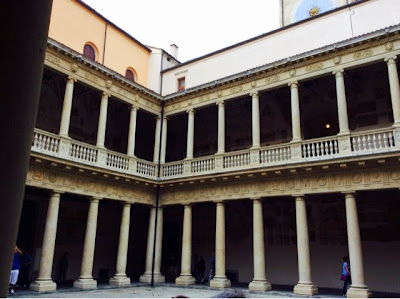On Friday morning, we started with "light stretching" on the sun deck led by the on-board physical therapist. On other days, we'd been treated to beautiful riverscapes or ancient architectural wonders, but this morning it was all about the giant Norwegian cruise ship coming around the corner and parallel parking directly behind our boat.
After our usual delicious breakfast, we boarded a bus for Verona, hyped for promotional purposes as "the city of love".
 |
| The ancient (and repaired with brick) Stone Bridge and the hills of Verona |
The city is built on a bend in the Adige river, with the oldest parts on the 'inside' and the newer (we're talking ninth century, here) constructions across the stone bridge in the hills.
Built around a system of squares, the city passed from one ruling dynastic family to another, each building their own sets of palaces next to each other, so the history of the city can be traced through its architecture.
 |
| Now a museum and university building |
It was by are the busiest and most crowded place we had been all week. Nowhere was that more true than the home of the 'Capulets', which includes a balcony, a well-loved statue of a young woman, and many many messages of eternal love. Entirely unnecessary, as far as I'm concerned, but luckily our walking tour didn't dwell there too long.
Instead, we made our way to the ancient Roman amphitheater, used today for the Verona opera festival in summertime.
 |
| Seats dropped into the Roman amphitheater |
The floor of the arena is raised and covered, half with seats, half with the stage. Seats (with back support) are also placed along the benches up the side, and the festival puts on a different opera every couple of days.
 |
| Not sure which production this is for, but quite a modernest take on whatever it is |
Some of the scenery is so large that it's moved by giant crane over the side of the amphitheater, rather than being brought in through one of the tunnels. It's then stored in the middle of the square outside, in front of City Hall.
 |
| Classical columns on City Hall to contrast the Egyptian set for Aida |
The first opera performed there was Verdi's
Aida in 1913. It's the only opera they perform every year, which took me a moment to remember, as we were staring at a phalanx of sphinxes during lunch. "Wait... aren't we in Europe?"






























